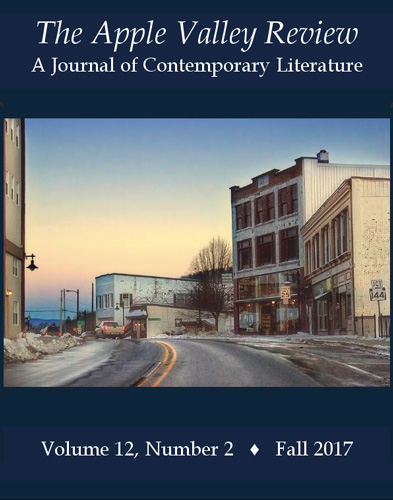Apple Valley Review – Fall 2017
Looking at the cover of the Fall 2017 issue of Apple Valley Review, I had the chills. A photo by Nicholas A. Tonelli of a town corner in winter, sun setting, and ice lining the road greets readers at the Apple Valley Review website, foreshadowing the Michigan winter waiting for me around the corner.
Looking at the cover of the Fall 2017 issue of Apple Valley Review, I had the chills. A photo by Nicholas A. Tonelli of a town corner in winter, sun setting, and ice lining the road greets readers at the Apple Valley Review website, foreshadowing the Michigan winter waiting for me around the corner.
The winter reminders aren’t just on the issue’s cover—writing within conjures up the chilly feelings as well. The speaker in “Nova” by Grant Clauser pleads with a mechanic to save his car, remembering a winter night in Ohio when he and his partner “tried to push it out / of a ditch, snow / filling gaps in my sleeves and hood.” Clauser makes the frustrating situation seem almost beautiful, the speaker’s memory rose-colored remembering:
we gave in,
caught a ride back to town
and slept late into the next day
trying to forget our stuck car.
And we made love that morning
like an eclipse,
or two far away lights
coming together in a crash
While I connected with this piece because I’ve experienced a very similar situation (as many people living in the rural Midwest have), others will still connect with Clauser’s clear description of the event and the feeling of not wanting to let something go when it holds memories.
In “After You Leave” by P. Ivan Young, the speaker also struggles with feelings of loss. Young writes with haunting images that emphasize feeling: “When I return to an empty house, / silence is made of you.” The speaker and the person he lives with exist only in each other’s absence:
One of us is always missing the other.
You’re the light under the bathroom door
I’m the impression in a living room chair,
I carry magazines with your name to the curb.
You make a salad with radishes I refuse to eat.
The poem feels lonely and empty, like the house the speaker shares, and Young’s two other poems in this issue (“Sunken Town” and “Mansions”) express the poet’s beautiful mastering of imagery and language to create a strong sense of place.
There is plenty more strong and beautiful poetry to enjoy this issue. Other standouts include Matthew Murrey’s stream of conscious style poem “New Year’s on I-75,” the speaker sharing the thoughts that invade when you have nothing to do but drive; Ken Autrey’s two poems about a “Penelope,” first “Smoking” and then “In Repose”; and Athena Kildegaard’s “Prairie Daughter (1936),” which reminded me of the “Migrant Mother” photograph by Dorothea Lange as I pictured the prairie daughter as one of the kids leaning on the migrant mother’s shoulders.
Lauren Fath’s two short pieces make up the only nonfiction found in this issue. “A Landlocked State” gives a whirlwind look at a relationship from beginning to end. The piece is tied together by the color of the ocean (or how one imagines it) and the idea of being landlocked, a beautiful metaphor I enjoyed seeing come full circle. In “The End of the Summer and the Touching, Too,” Fath wistfully writes about perhaps the same relationship, and the small changes that occur as it, like the summer and the touching, may be coming to an end.
There are three pieces of fiction by two writers in this issue: “Hairline Cracks” by Dara Passano, and “Migrant” and “The Book of Beginnings” by Murali Kamma, who writes immigrant characters to life in both pieces.
In “Hairline Cracks,” Passano introduces us to four characters: the narrator; Pascal, perhaps the narrator’s lover; a diplomat; and the diplomat’s lover. As they make their way to the diplomat’s house where his lover waits to greet them, Pascal and the narrator comment on the part of town they traverse through: “These new neighbourhoods, Pascal shouted, and I nodded, forgetting he couldn’t see me. No hawkers, no drilling, no music, no life.” Once they reach the diplomat’s house, the narrator observes the house, everything “too new [ . . . ] like a painting,” and everything inside seems just as artificial and sterile. There are empty vases, unread books bought in bulk to fill shelves, and paintings that are only copies of originals. To readers, it all seems artificial—not just the house, but also the interaction between the characters as the narrator and Pascal repeatedly humor the diplomat. At one point, the narrator notices a hairline crack in the bowl the lover is eating from. As the story progresses, we see the hairline crack in the perfect façade of the diplomat and the house and the neighborhood. Nothing is as perfect as it seems. The narrator doesn’t buy into the falsities, and because of this, neither do we. We see the artificiality and it becomes like a shared joke between reader and narrator.
Winter is waiting right around the corner and Apple Valley Review is aware of it. In the Fall 2017 issue, ease into the upcoming cold weather with poetry and prose sure to leave readers feeling a little warm inside.
[www.applevalleyreview.com]






